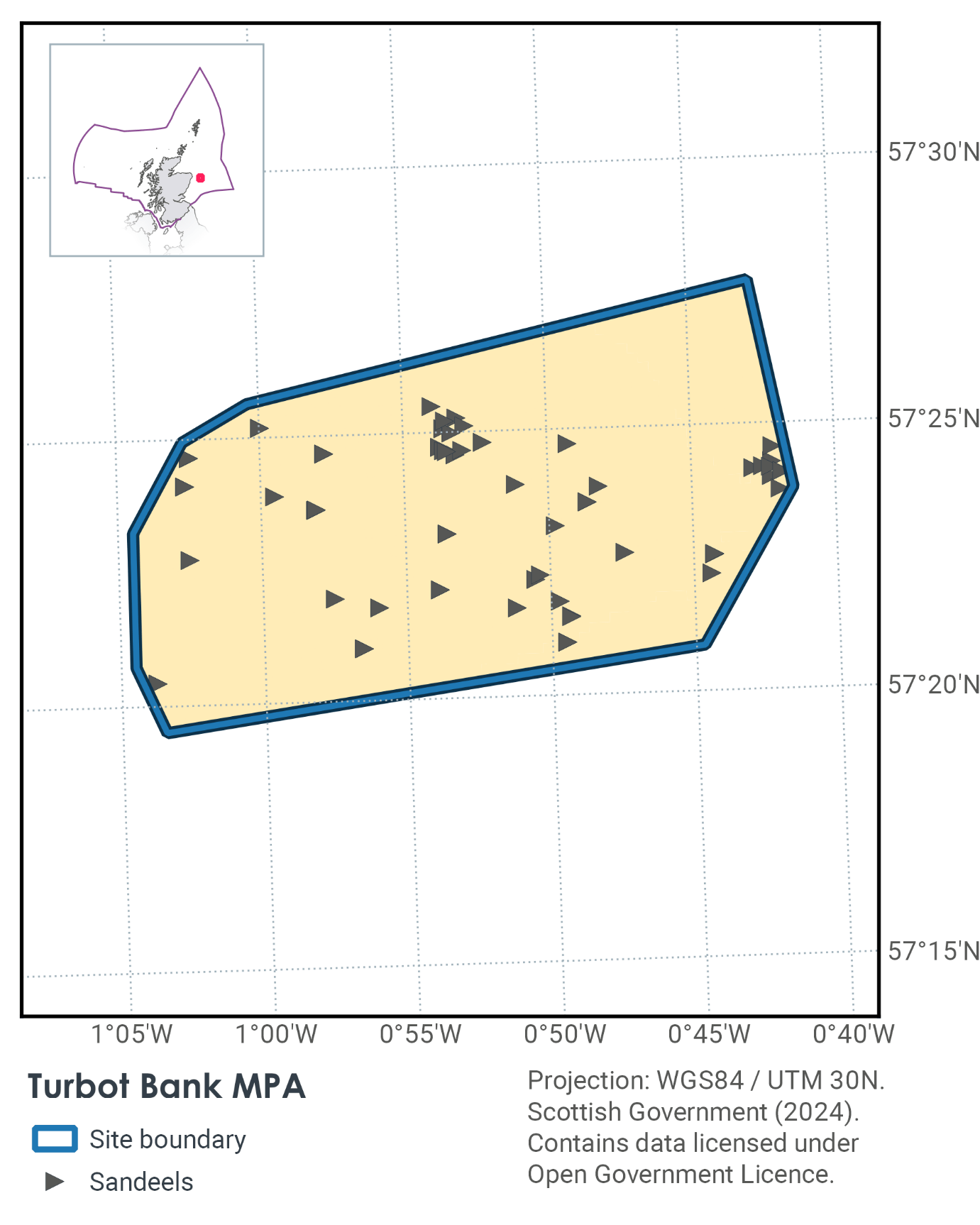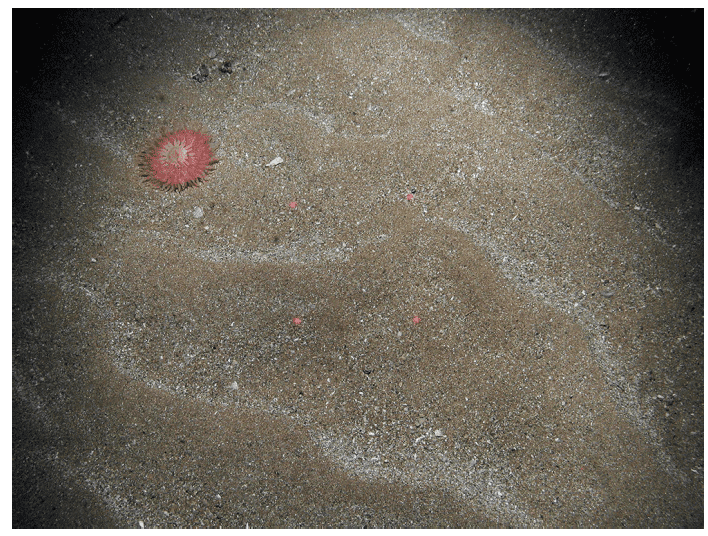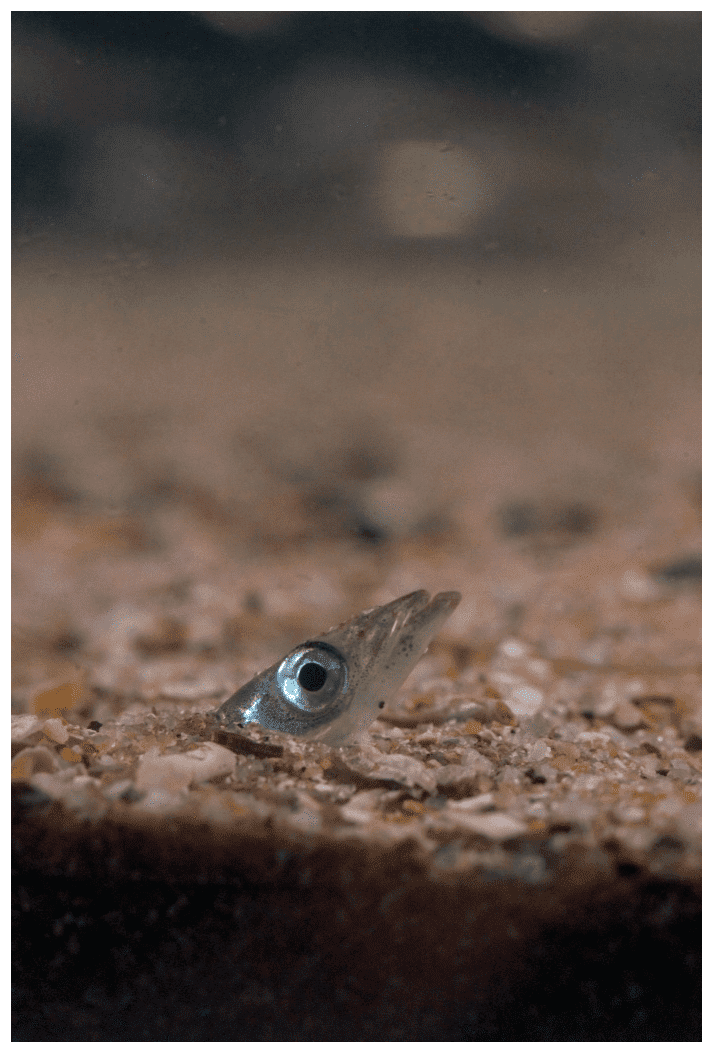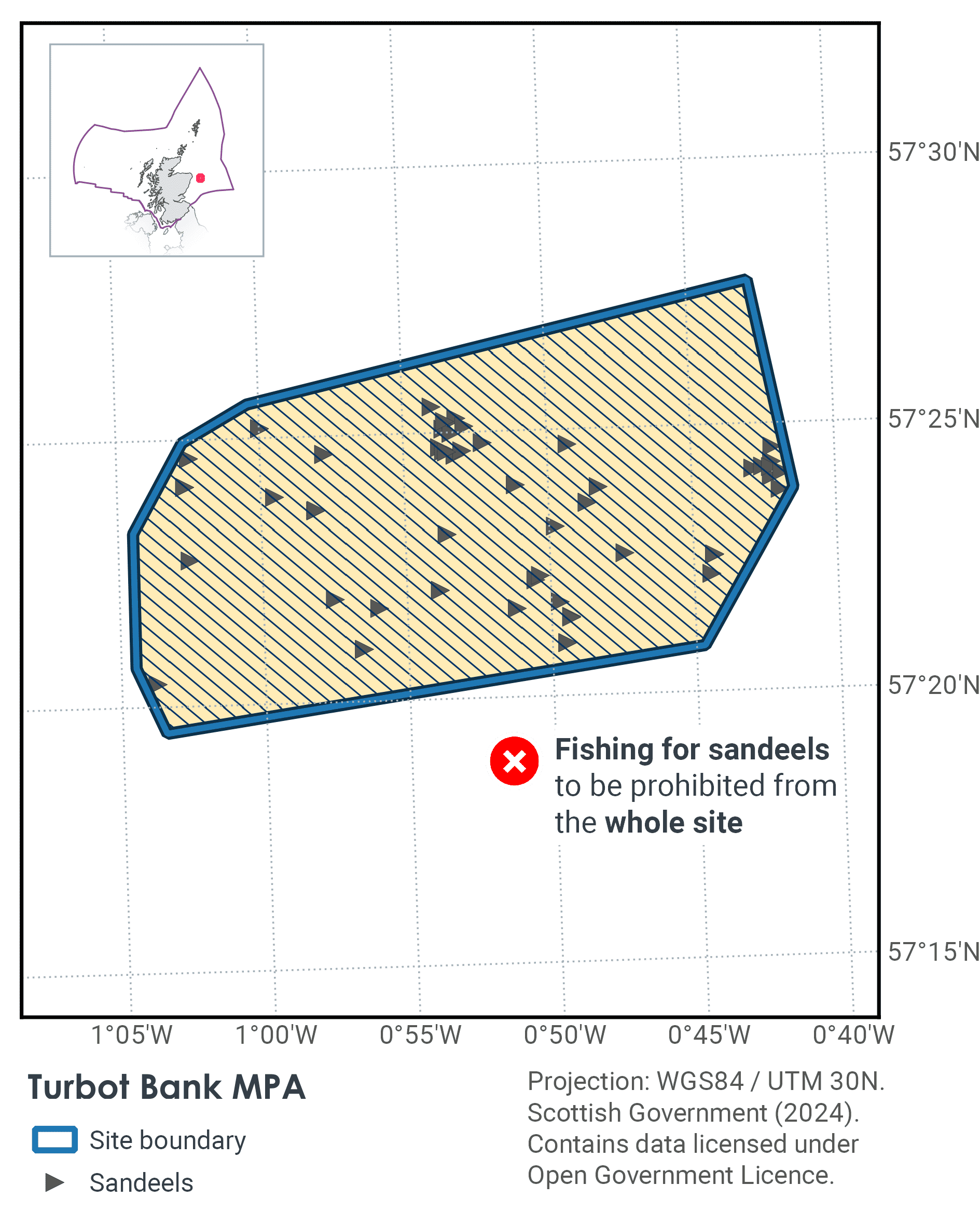Fisheries Management Measures within Scottish Offshore Marine Protected Areas (MPAs) - Site Proposal Document
This document describes the process, justification and evidence used to develop site specific management measures. It outlines key information for each site including their features, and risks of potential pressures.
16. Turbot Bank MPA
16.1 Description and background
Proposed measures were developed for Turbot Bank MPA in which it was proposed that targeted sandeel fishing across the full site would be prohibited. In 2023 the Scottish Government consulted on a closure to all fishing for sandeel in all Scottish waters. As a result of this consultation the Scottish Government has prohibited fishing for sandeel in all Scottish waters. The Sandeel (Prohibition Of Fishing) (Scotland) Order 2024 came into force on 26 March 2024 ahead of the 2024 fishery season and applies to all vessels (UK and EU) fishing within Scottish waters.
Subsequently, we are no longer proposing site specific measures for Turbot Bank MPA and therefore measures for this site are not included within this consultation. The site will still feature within the package of consultation documents as removing the site from the documents is not considered practical at this stage. This is because in addition to site specific assessments, overall assessments have been undertaken for the impacts of implementing measures as a full package.
This MPA for sandeels is located 44 km east of Peterhead in the North Sea as shown in Figure 39 and Figure 41. It forms part of a broader area of sandy sediment also known as ‘Turbot Bank’. The MPA covers an area of 251 km2 and ranges in depth from 60 m to 80 m around the bank’s margins.
Turbot Bank is important for sandeels, particularly Raitt’s sandeel Ammodytes marinus, which is closely associated with sand habitats, living buried in the sand for months at a time. The site contains the type of sandy sediment with low silt and clay components that sandeels prefer (Figure 40; Wright et al., 2000; Holland et al., 2005). Their life strategy means sandeel aggregations are potentially vulnerable to localised depletion, and, in the past, this part of Turbot Bank has been subject to occasional intensive sandeel fisheries. Additionally, data on sandeel larvae and models of larval transport indicate that the larvae hatching from Turbot Bank may be widely dispersed throughout the north-west North Sea (Proctor et al., 1998; Christensen et al., 2008). The sandeels present at Turbot Bank are one of two key components of the ICES sandeel assessment 4 area (the other being the Firth of Forth Banks; ICES, 2010).
Sandeels play an important role in the wider North Sea ecosystem, providing a vital source of food for seabirds such as Atlantic puffin Fratercula arctica and black-legged kittiwake Rissa tridactyla, fish such as plaice Pleuronectes platessa and marine mammals such as dolphins, so it is important to maintain sandeel abundance at a level high enough to provide food for a variety of predator species.
Sandeels are also a commercially important stock for EU member states, Denmark in particular. Protection of Turbot Bank to enable maximum larval transport will help maintain or improve the health of the stock elsewhere in the North Sea.
Further information can be found in the Site Information Centre.

16.2 Site Features
The Turbot Bank MPA is designated for the following protected feature:
- Sandeels.
Sandeels are considered to be a priority in terms of marine conservation in Scotland’s seas and appropriate for spatial management.
The MPA is considered to be an important area for the net export of sandeels to support recruitment in grounds to the south and east of Turbot Bank (Marine Scotland Science, 2012). Larvae from Turbot Bank may be widely dispersed throughout ICES sandeel assessment area 4 and occasionally beyond this area (Proctor et al., 1998; Christensen et al., 2008). The association between the sandeels and sediment types within the MPA is typical of that known for the species (Wright et al., 2000).
More information regarding the site selection process for the Turbot Bank MPA is available in the detailed assessment against the Scottish MPA Selection Guidelines.



Figure 40. Images representing a) coarse sand and b) rippled sand with an anemone (Urticina sp.) within the Turbot Bank MPA - sediments typically associated with sandeels ©JNCC/Cefas. Image c) partially burrowed sandeel ©Keith Mutch, MSS.
16.3 Site Boundary
The boundary has been set in accordance with the boundary setting principles outlined in the MPA Selection Guidelines.
It has been drawn to focus on the sample records of relatively high densities of sandeels together with areas of those sediments considered suitable for colonisation by sandeels in the vicinity of Turbot Bank. Population data came from the Scottish Government Marine Directorate (previously Marine Scotland Science) east coast sandeel dredge survey from 2008-2011, and samples collected in 2012 as part of a seabed habitat survey of Turbot Bank (Eggleton et al., 2013). Information on suitable sediments is based on the analysis in Wright et al. (2000) and seabed habitat mapping (Sotheran & Crawford-Avis, 2014).
The boundary to the west reflects the full extent of the Turbot Bank shelf bank and mound feature based on interpretation of high resolution multibeam and backscatter data. This area is included because sandeels have been reported to aggregate in dense schools at the edge of banks, which may represent areas preferred for feeding (Van der Kooij et al., 2008).
Confidence in the presence and extent of the protected features has been set out in the Data Confidence Assessment.
16.4 Conservation objectives
JNCC’s view on the overall condition of the site’s qualifying feature is that it is in favourable condition and therefore needs to be maintained at favourable condition.
The Conservation Objective for the Turbot Bank MPA is that the protected feature (Sandeels) listed below –
- so far as already in favourable condition, remain in such condition; and
- so far as not already in favourable condition, be brought into such condition, and remain in such condition
The full conservation advice documents can be found on the JNCC website. This includes the formal conservation advice for the site, background information and the full conservation objectives.
16.5 Pressure from demersal mobile fishing gear
Sandeels are targeted using small-mesh demersal trawl gear. Most of the catch consists of Ammodytes marinus, but other sandeel species are caught as well. Industrial trawl fisheries targeting sandeels can cause local depletion and alter the age and size composition of the sandeel population. Depletion of the stocks may lead to reduced recruitment and export of larvae to other areas and reduced availability of prey for predators.
There is little evidence regarding the sensitivity of sandeels to other demersal mobile gears. The larger-mesh trawl and seine nets used to catch whitefish and Nephrops norvegicus do not generally catch sandeels and therefore are not expected to have any direct impact. There is some evidence that scallop dredges can kill sandeels buried in the sediment (Eleftheriou & Robertson, 1992), but work from Scottish Government Marine Directorate has shown that even when equipped with a fine mesh net to sample sandeels, the efficiency is < 12% (MSS, unpublished data) and these are therefore not considered to pose a significant risk.
The sensitivity of sandeels to hydraulic methods is likely to pose the greatest risk of all demersal mobile gear used in Scotland based on the extent to which they penetrate/disturb the sediment.
16.6 Pressure from demersal static fishing gear
Sandeels are not caught by static gears and the impact of these gears is therefore considered to be minimal.
16.7 Levels of fisheries management considered
Table 26 provides a summary of the management advice set out against the various options that have been considered.
(Table 26) Summary of fisheries management advice for Turbot Bank MPA
Management options considered for demersal mobile gears
No additional management: This level of management is considered adequate to achieve the conservation objective for sandeels. The absence of a targeted sandeel fishery in this site at present means that there is currently a low risk to achieving the conservation objective. If there was a directed sandeel fishery there would be a risk of not achieving the conservation objective for sandeels.
Reduce / limit pressures: If a sandeel fishery were to develop in the future, This level of management would reduce the risk of not achieving the conservation objective for sandeels. Appropriate management could include a limit on catches to avoid localised depletion.
Remove / avoid pressures: If a directed sandeel fishery (including fishing for scientific investigation) were to develop in the future, This level of management would reduce the risk of not achieving the conservation objective for sandeels to the lowest possible levels.
Management options considered for demersal static gears
No additional management: It is unlikely that any additional management of static gear activities will be required as the risk of not achieving the conservation objective for sandeels associated with these activities is minimal. However, if static gear fishing activities were to start and monitoring showed evidence of detrimental effect, it may be necessary to apply limits in the future.
16.8 Other fisheries measures which apply to the site
The existing East of Scotland sandeel closed area (Regulation (EU) 2019/1241) partly overlaps with the MPA in the western part. This will be making a contribution towards achieving the conservation objectives.
On 31 January, the Cabinet Secretary for Rural Affairs, Land Reform and Islands announced that the Scottish Government would be proceeding with prohibiting fishing for sandeel in all Scottish waters. The Sandeel (Prohibition Of Fishing) (Scotland) Order 2024 came into force on 26 March 2024 ahead of the 2024 fishery season and applies to all vessels (EU and UK) fishing in these waters. The decision follows a detailed analysis of all responses and representations received to the 12-week consultation on this issue and which closed on 13 October 2023.
16.9 Proposed fisheries management and rationale
Table 27 and Figure 41 provides details of the proposed management approach and further explanation is provided below.
(Table 27) Proposed management approach for Turbot Bank MPA
Species: Sandeels
Gear type: Sandeel fishery
Proposed management: Remove / avoid pressures
Measures: Prohibit targeted fishing for sandeels within the whole MPA.
The risk analysis shows that fishing with hydraulic gear may pose the greatest threat. However, with a minimum depth in the MPA of 60 m such activity is unlikely to ever occur. There has been a targeted sandeel fishery in the past, and recommencement of this fishery would hinder the achievement of the conservation objectives. Therefore, to prevent this, a prohibition on landing or retaining on board sandeels is proposed. This is the same provision that is in place already on the East coast of Scotland.
Turbot Bank SAC is an important area of sandeel productivity which supports other parts of the North Sea. It therefore has a key role in the availability of sandeels to support marine species which depend upon them as a food source. These measures should also further progress towards Good Environmental Status in the Greater North Sea, particularly in relation to Descriptors 1 (biological diversity), 3 (commercial fish and shellfish) and 4 (food webs).

Northwest Water Sites
Contact
Email: marine_biodiversity@gov.scot
There is a problem
Thanks for your feedback